|
This review page is supported in part by the sponsor whose ad is displayed above
|
||||||||||||||
 |
||||||||||||||
 |
||||||||||||||
Reviewer: Mike Malinowski Source: Walker Proscenium Gold turntable; Walker Reference phono preamp; Clearaudio Reference Wood cartridge; Goldfinger Preamp: VTL 7.5 Reference Amp: darTZeel NHB-108 Speakers: Wilson X-2 Alexandria Cables: Transparent Opus, Silent Source, Omega Mikro Ebony speaker cables; Transparent XL w/MM interconnect to amp; Omega Mikro between phono pre and preamp Stands: Michael Green racks, VPI phono stand, Zoethecus, Walker Prologue Amp Stand [on review] Powerline conditioning: Furman Balanced Power, Walker Audio Velocitor S, PS Audio 300 Sundry accessories: Valid Points resonance control discs; ASC tube traps; Echo Buster absorbent and diffuser panels; Argent Room Lens; separate 90-amp sub panel feeding five dedicated cryo'd outlets; Loricraft Model 4 record cleaner Room size: 22' x 17' x 8' (double sheetrock on 2"x 6" framing in basement) Review component retail: from $1,150 - $1,650 depending on wood (Rock Maple or Jatoba) and standard or Reference level Valid Point trim |
||||||||||||||
 |
||||||||||||||
Introduction Vibration control seems to fall into that mystical category of components which fragment the audio community into believers and non-believers, somewhat akin to the world of cables. Heated debates, scientific and pseudo-scientific discussions abound. I'm sure it's of little surprise that I come down clearly in the believers' camp. With my ears as my sole guide, I found that isolating components from structural and airborne vibrations can offer a quick and easy audible upgrade. Sounds simple - and non-believers need not apply. An entire industry has evolved for just such purpose, with enough competing technologies to make both your head and pocketbook spin: mass loading, dampeners, decouplers, air, wood, sand, lead, exotic metals like carbon fiber and Kevlar - and I've probably left some out. To make matters more complex, each designer has chosen a different path; coupling, decoupling, dampening and draining are all in play throughout the industry. Each has an effect and whether that effect is good or bad is another discussion. But honestly, most do help to some degree. The challenge is finding the right combo. Remember one of the first ad campaigns to raise awareness of high blood pressure: "High blood pressure - the silent killer"? With tongue partially in cheek, vibrations are an audio equivalent - insidious with no external manifestations. Left untreated, they will introduce distortions not just for my fellow vinylphiles seeking to maximize that delicate interface of stylus and groove. Nope, everything is affected, from CD players through solid-state amps. The Prologue amp stand appears to be the utmost in simplicity but with most things Walker, looks can be deceiving. It looks like a butcher block board, actually a stunningly beautiful butcher block board with Walker's ubiquitous Valid Points as feet. There is no air bladder, carbon fiber or exotic dampener in sight, just plain old wood and lead-filled brass. Commenting on the butcher block look, Walker corrected me, describing it as "butcher block-type construction". He finally accepted the generic description while emphasizing it to not even be close to what one might find in a kitchen. |
||||||||||||||
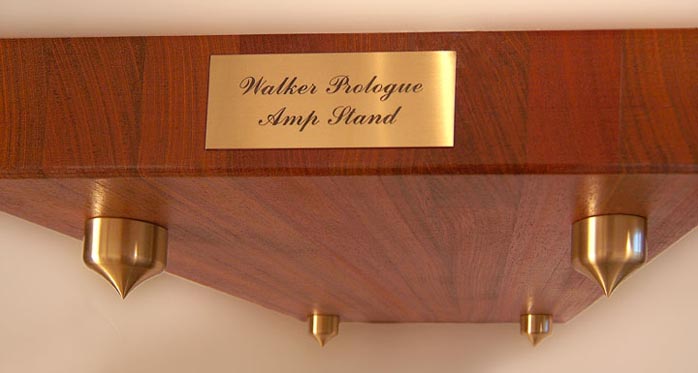 |
||||||||||||||
"I use different densities of the wood, with the grain turned in different directions to achieve the resonance control I want. I don't like one solid piece of wood because it is connected from one end to the other, vibration-wise; whereas in this type of construction, it is not." Additionally, Lloyd prefers mass. At about 70 pounds, this sucker is heavy. "I much prefer mass, you can tell, on everything because everything vibrates. If something is light and it vibrates, it has to also vibrate whatever it is sitting on. Even the earth itself vibrates, never mind the sound fields in your room. Mass gives it something strong and stable. With the type of assembly we use here, reflective vibrations back and forth are eliminated; anything remaining is damped with resonance control disks. In fact, it comes with one in the standard package and the Valid Points are actually screwed into the wood almost all the way through to get a good grip on the internal vibrations from top to bottom." The standard version comes with four valid points coupling the stand to the floor and one resonance control disc for the stand; the reference version adds an additional set of Valid Points for the amp and five additional resonance control discs for the amp. Construction "Tweaker" doesn't begin to describe Lloyd Walker. The Prologue is the final iteration of about twenty different test designs including horizontal and vertical lamination, particle boards and different types of wood, culminating in the current design. Originally the stand was developed using Rock Maple but Walker's new wood of choice, Jatoba, is even harder and denser than Rock Maple. So hard in fact that Walker snapped multiple steel taps during the construction of these stands. The Janka hardness test measures the force required to embed a .444 inch steel ball to half its diameter in wood. Black Walnut measures 1010, Hard Maple at 1450, Mahogany at 2200 and Walker's Jatoba (Brazilian Cherry) an impressive 2350. It is over twice as hard as Maple and 50% harder than Mahogany. If Walker's correlation between hardness and audible improvements is correct, then based on this scale, Jatoba should be a good choice. As to the finish, the deep lustrous Cherry is off the charts with the look of fine furniture. The WAF doesn't get higher than this. One would assume poly finish or possibly lacquer. Bu Lloyd points out that sliding amps and Valid Points on and off the stand would ultimately cause scratches no matter how careful one is. "With poly, you're in trouble. You've got sanding and work. With six coats of hand-rubbed tongue oil, most minor scratches are easily repaired with Liquid Gold." Lloyd bristles when asked if he was designing for a certain sound. "I was looking for neutrality. I was not looking to create some artificial harmonic vibrations to make the sound in a bad-sounding system or with a bad CD sweeter. If you do that, you just reverse yourself. When you have a good CD or a good LP, it'll sound bad." I had inadvertently piqued a major pet peeve of Walker's - components and accessories that make bad-sounding equipment and recordings sound good. Walker continued by complaining of reviewers coming to his sound rooms at shows. They would state that the sound was excellent but then insist on hearing a bad recording. "Why bother and drive all the other people out of my room? If it's no good, why listen to it in the first place? I want to hear what's on the recording, I don't want to color it. Put on a bad recording and it should sound bad." Walker's design goal for the Prologue was to eliminate vibrations and prevent the addition of resonant interfaces which would color the sound, and which in turn could make a good recording sound bad. |
||||||||||||||
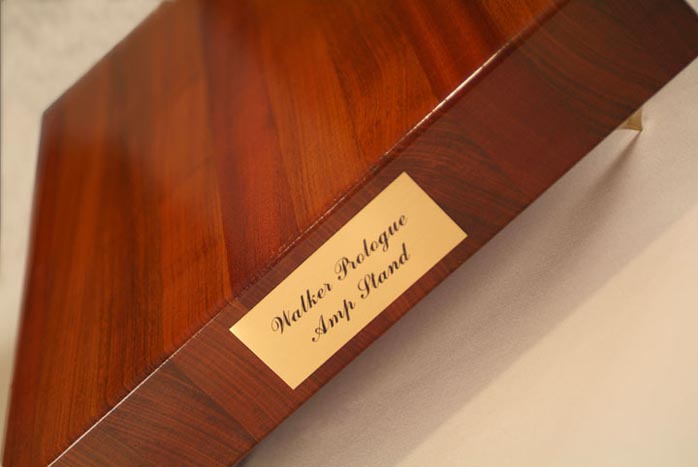 |
||||||||||||||
In practical application, vibrations must be reflected, dampened or transmitted. Walker claims that this humble, non high-tech stand does all three in synergistic union. The laminate construction and breaks between wood staves provide the dampening, the valid points couple vibrations to ground and the vibrating surface of the stand is tamed by the leaden resonance control discs. "That's why the amp stand comes with a one-inch disc in its basic format and four points. That one-inch disc is very, very important. It stops any reflected vibration that would come from your amp sitting on points -- or your amp sitting on the amp stand -- that might develop because of four points being loaded down heavily. This means that your amp sitting on its four rubber feet would absorb a little reflected resonance. When you get any four surfaces rigidly tied down, you create a drumhead in the middle. I don't care what you make it out of, you'll get a slight, tiny amount of drum-head effect. That's why that one-inch resonance control disc is supplied. To absorb that kick-back." The stand with four valid points, not three, brings up the question of optimal balanced loading. "We no longer drill and tap in threes or five positions to give the user a choice because this wood is so hard and rigid in itself. Four works just as well because we've located the positions of the footers so specifically. There is really no benefit to three. It's actually a detriment when you get down to it. Two corners would be left unsupported to form a long link, which in turn becomes two free wing tips." "Not only that but with three, it's too easy for you to walk over there and decide you want to lift your amp and maybe put one foot on one edge and then you skew the stand, drop the amp and risk thousands of dollars. However, I do recommend you set your amp on the stand with three Valid Points between them if at all possible." |
||||||||||||||
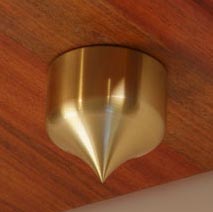 |
With characteristic bluntness, Walker contends that some amp stands are nothing more than a pretty way to get your amps off the ground and that many do as much damage as good. The Prologue is an offshoot of his development for the reference platform used for the Proscenium Gold Turntable. If you really want to go crazy and have $6,500 burning a hole in your pocket, Walker offers this custom-matching rack to complement the Prologue amp stand. Hand-made carbon fiber supports, brass lock nuts, 1.5" shelves, threaded brass rods from top to bottom filled with fine lead shot... the weight of the rack reaches 500 lbs and is finished to the same Prologue standards. It is visually magnificent and the reference rack for Lloyd's personal system. The Prologue is simple and elegant. Is it effective though? |
|||||||||||||
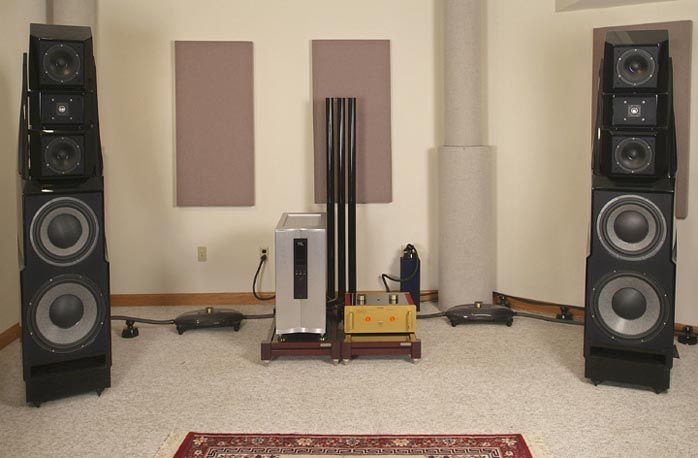 |
||||||||||||||
The journey With the purchase of the Linn turntable some twenty years ago, I began my foray into -- and sometimes out of -- vibration control. Linn spurred a debate as to the sonic impact of the player's stand. It was somewhat revolutionary at that time because most of us were happily putting our turntables on a convenient table or shelf, certainly with none of the sophistication of today's solutions. If my memory cells are up to speed, the Linn sound varied with the rigidity of the stand, with many arguing that a flimsy support sounded best. The Linn was and is an excellent table and sure enough, the stand it was put on did make an audible difference. That started a seemingly endless parade of stands, racks and devices all claiming to eliminate, modify or dampen vibrations. I went through most of the flavors of the month - air, sand, hard and soft and they all made a change. But the changes were not uniform, consistent and reliable. Some shifted the tonal characteristics, some worked well with a CD player but not with a preamp. Only a few consistently improved the sound of amplifiers. That was up until the Zoethecus. They were the first to offer a consistent and uniform improvement no matter what the amp. From the massive Levinson 34hs to the tube-laden Tenor 75s, the Zoethecus stand improved clarity, definition and detail. It had an uncanny ability to snap the soundstage into focus and to add a consistent clarity to the presentation. Yes, solid-state amps at times sounded slightly cooler but the benefits always outweighed the shortcomings. Those stands clearly, consistently and uniformly improved the sound of any amp in my arsenal, tube or transistor. I sometimes wondered if there was a reduction in warmth with the Zoethecus or whether I was reacting to the increase of detail but no matter, I was happy for a long time. In my mind that problem was solved and I could tackle real audio problems like speakers or amps. So there I sat for many years completely contented with my Zoethecus and somewhat oblivious to the alternatives. |
||||||||||||||
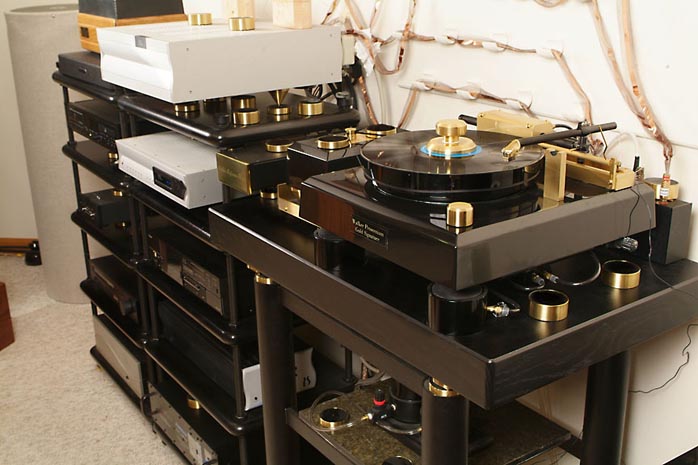 |
||||||||||||||
The newest amp in my quiver is the spectacular darTZeel 108 and interestingly, it showed the least improvement while perched on the Zoethecus - a slightly tighter focus and slightly increased depth. I would be happy with the darTZ with or without Zoethecus. Then came Walker. I live geographically close to Walker Audio and am fortunate to be at the forefront of auditioning many of Walker's tweaks and inventions. For over a year, he offered to bring his Prologue amp stands for a quick shoot out against the Zoethecus. With his quirky charm and ineffable cockiness, he claimed that it "... would beat the pants off the Zoethecus". I, on the other hand, was skeptical. However, when someone like Lloyd with his 98% batting average throws down the gauntlet, you eventually accept the challenge. We did the full reference setup with Valid Points under the amp and resonance control discs on the amp and the stand. Of course, the Prologue rested on its own set of Valid Points spiked to the carpeted concrete floor of my listening room. When you have been dabbling in hi-end audio for almost 30 years, you'd think that instances of unexpected surprises might dwindle to few and far between. Well, this was one of the few. The Prologue is spectacular and quite unexpectedly so. It alters neither harmonics nor tonal qualities. The wonderful intrinsic qualities of the darTZ remain. What the support does in one fell swoop is to take each of the elements which were present and coalesce them. This is analogous to an instantaneous shift from multi-driver to electrostatic speaker. Full-range electrostatics are generally more seamless top to bottom than even the best multi-driver units. Assume all else to be equal and then make the leap to stats. That is the type of change provided by the Prologue. Don't get too hung up on the electrostatic speaker comparison. I am not saying that the Prologue stand will make your system sound like you have stats or planars. I am talking conceptually here. In addition, the Prologue took the already superb darTZeel soundstage and made it deeper and wider, with a noticeable increase of clarity and micro dynamics. |
||||||||||||||
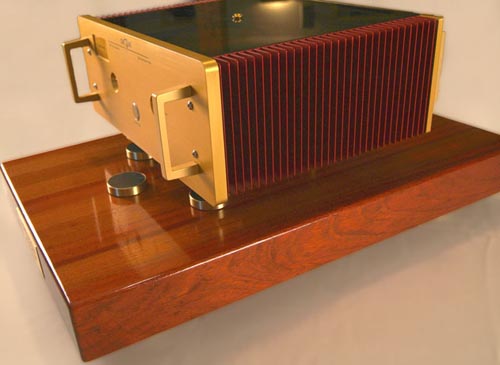 |
The improvement in sound was both immediate and obvious. The soundfield snapped into coherent and uniform focus. From top to bottom, instruments and images were more stable and more tightly focused. On Liszt's Hungarian Rhapsody No. 2 [Antal Dorati London Symphony, Mercury], the music starts small before growing in complexity and density. The Prologue allows you to better feel and sense the building of the momentum. The Prologue system doesn't add bass nor change the rich textures but it does add some tautness and definition to the sound, especially noticeable with my other amplifier reference, the VTL S-400 tube amp. | |||||||||||||
I find myself looking to turn the volume up slightly more than average, which is interesting. At lower volumes, the micro detail that adds that wondrous sparkle, life and vitality is noticeably increased. Maybe it's just my wanting more of a good thing. Overall, the Prologue is like a tune-up for your system, providing darker blacks and an easier presentation. |
 |
|||||||||||||
| With Walker, there are no attempts to tune resonances because he realizes that the musical event is really quite fragile in nature. Any attempt to manipulate or alter this delicate balance | ||||||||||||||
| pushes you farther away from the musical truth, not closer. Whether a specific recording sounds better or worse is only an indictor of the encoded musical truth, not a manipulation of the sound. A dramatic example was the AR VT100 amp. (I don't know which version, but it was about 10 years ago.) Compared to a Classé amp, my first reaction was sweet, melodic and beautiful. So was my second reaction, and third, fourth and 22nd. The problem became that some things are not sweet, melodic and beautiful. The ARC homogenized the sound by forcing it though an aural filter - a beautiful filter to be sure but a filter nonetheless. Bad recordings came out sweet - brass, strings, voices all came out sweet. Always. When Rod Stewart, Willy Nelson, Kim Carnes and Bob Dylan all start to sound sweet, we have departed from the world of neutrality. And whether it is a stand that attempts to manipulate the resonance or an amp which puts a "melodic filter" on the music, once this coloration enters the reproductive chain, you can never remove it. The damage is done. It might be pleasing but it sure isn't accurate. The only other choice is to remove, destroy and eliminate vibrations so they don't alter the signal. At that point, we get one step closer to the original musical event. |
||||||||||||||
 |
||||||||||||||
Summary The Prologue is beautiful, musical and effective. Not the least expensive stand on the market, it is far less expensive than a component upgrade - and we're talking about a major sonic upgrade. The improvement in clarity and focus is rather startling. Musicians now seem to be playing as a unified whole, not as the sum of singular instruments. The term cohesiveness pops into my brain every time an amp is placed on the Prologue, yet the character and sonics of the amp remain unchanged. I wondered though if a poor audiophile could gain a significant part of this performance with a home-built DIY version. Walker admitted that a DYI version might offer improvements. "But it'll depend on the compromises you are willing to make. Some manufacturers use a solid slab of maple. Is it going to work as well as the Prologue? Absolutely not! Maybe you'll get 80%, maybe you'll get 50%. If you are on a strict budget and the Prologue is out of reach, you might want to go that way." As for the genuine article, it may not be cheap but it is certainly most effective. In the world of insane component pricing and in view of the sonic improvement offered, I consider it an excellent value. Highly recommended. |
||||||||||||||
 |
||||||||||||||
 |
||||||||||||||
|
Manufacturer's website
|
||||||||||||||
 |
||||||||||||||